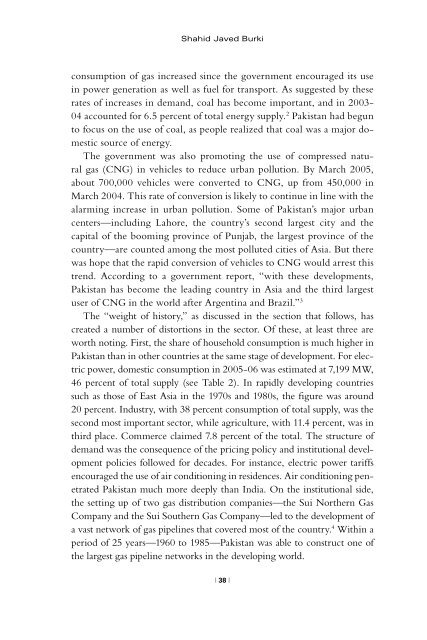fueling the future - Woodrow Wilson International Center for Scholars
fueling the future - Woodrow Wilson International Center for Scholars
fueling the future - Woodrow Wilson International Center for Scholars
- No tags were found...
Create successful ePaper yourself
Turn your PDF publications into a flip-book with our unique Google optimized e-Paper software.
Shahid Javed Burkiconsumption of gas increased since <strong>the</strong> government encouraged its usein power generation as well as fuel <strong>for</strong> transport. As suggested by <strong>the</strong>serates of increases in demand, coal has become important, and in 2003-04 accounted <strong>for</strong> 6.5 percent of total energy supply. 2 Pakistan had begunto focus on <strong>the</strong> use of coal, as people realized that coal was a major domesticsource of energy.The government was also promoting <strong>the</strong> use of compressed naturalgas (CNG) in vehicles to reduce urban pollution. By March 2005,about 700,000 vehicles were converted to CNG, up from 450,000 inMarch 2004. This rate of conversion is likely to continue in line with <strong>the</strong>alarming increase in urban pollution. Some of Pakistan’s major urbancenters—including Lahore, <strong>the</strong> country’s second largest city and <strong>the</strong>capital of <strong>the</strong> booming province of Punjab, <strong>the</strong> largest province of <strong>the</strong>country—are counted among <strong>the</strong> most polluted cities of Asia. But <strong>the</strong>rewas hope that <strong>the</strong> rapid conversion of vehicles to CNG would arrest thistrend. According to a government report, “with <strong>the</strong>se developments,Pakistan has become <strong>the</strong> leading country in Asia and <strong>the</strong> third largestuser of CNG in <strong>the</strong> world after Argentina and Brazil.” 3The “weight of history,” as discussed in <strong>the</strong> section that follows, hascreated a number of distortions in <strong>the</strong> sector. Of <strong>the</strong>se, at least three areworth noting. First, <strong>the</strong> share of household consumption is much higher inPakistan than in o<strong>the</strong>r countries at <strong>the</strong> same stage of development. For electricpower, domestic consumption in 2005-06 was estimated at 7,199 MW,46 percent of total supply (see Table 2). In rapidly developing countriessuch as those of East Asia in <strong>the</strong> 1970s and 1980s, <strong>the</strong> figure was around20 percent. Industry, with 38 percent consumption of total supply, was <strong>the</strong>second most important sector, while agriculture, with 11.4 percent, was inthird place. Commerce claimed 7.8 percent of <strong>the</strong> total. The structure ofdemand was <strong>the</strong> consequence of <strong>the</strong> pricing policy and institutional developmentpolicies followed <strong>for</strong> decades. For instance, electric power tariffsencouraged <strong>the</strong> use of air conditioning in residences. Air conditioning penetratedPakistan much more deeply than India. On <strong>the</strong> institutional side,<strong>the</strong> setting up of two gas distribution companies—<strong>the</strong> Sui Nor<strong>the</strong>rn GasCompany and <strong>the</strong> Sui Sou<strong>the</strong>rn Gas Company—led to <strong>the</strong> development ofa vast network of gas pipelines that covered most of <strong>the</strong> country. 4 Within aperiod of 25 years—1960 to 1985—Pakistan was able to construct one of<strong>the</strong> largest gas pipeline networks in <strong>the</strong> developing world.| 38 |
















